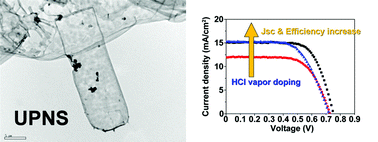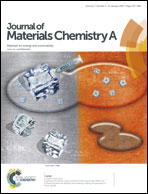Ultrathin polypyrrole nanosheets doped with HCl as counter electrodes in dye-sensitized solar cells†
Abstract
Ultrathin polypyrrole nanosheets (UPNSs) were synthesized by chemical oxidation via organic single-crystal surface-induced polymerization (OCSP) using sodium decylsulfonate (SDSn) as a template. This process yields mass-producible, inexpensive materials that are suitable for flexible devices. UPNSs were deposited onto transparent, conductive oxide glasses for use as catalytic counter-electrodes (CEs) in dye-sensitized solar cells. These electrodes boast 94% transmittance against that of Pt CEs. Hydrochloric acid (HCl, 35 wt%), applied in the vapor state as a post-doping process, was used to improve the catalytic activity of the electrodes. This treatment enhanced the catalytic activity of UPNSs by increasing their conductivity by 8 S cm−1, with a 7.4% increase in the level of nitrogen doping. The Tafel polarization and impedance results support the enhancement of catalytic activity due to HCl doping. Dye-sensitized solar cells (DSSCs) employing the HCl-enhanced UPNS CEs showed a power conversion efficiency (AM 1.5, 100 mW cm−2) of 6.8%, which is 19.3% greater than the untreated case and comparable to that of Pt CE-based DSSCs.


 Please wait while we load your content...
Please wait while we load your content...